Rural Prosperity
A Flame that Warms the Heart: The Ujjwala Story
Posted On: 08 AUG 2025 6:25PM
“Ujjwala Yojana has strengthened the lives of the poor, marginalised, Dalits and tribal communities. This initiative is playing a central role in social empowerment.”
- Prime Minister Narendra Modi
- The Pradhan Mantri Ujjwala Yojana (PMUY) has provided over 10 crore LPG connections as of July 2025, empowering rural households with access to clean cooking fuel.
- Women save 2 to 3 hours daily, previously spent collecting firewood, which they now use for income-generating activities or family care.
- The government has approved targeted subsidy of Rs.300 per 14.2 kg cylinder for up to 9 refills per year for PMUY beneficiaries.
Introduction: Lighting Her Kitchen
Across India’s vast expanse of 3.28 million square kilometres, countless stories of women, of strength, sacrifice, and resilience, goes unheard.
The Union Cabinet recently approved the targeted subsidy of Rs.300 per 14.2 kg cylinder for up to 9 refills per year (and proportionately pro-rated for 5 kg cylinder) to the beneficiaries of Pradhan Mantri Ujjwala Yojana (PMUY) during FY 2025-26 at an expenditure of Rs 12,000 crore.
|
In urban homes, women plan their evening meals, perhaps a hearty dal or a sweet kheer, focused on what to serve. But in India’s villages, women once faced a tougher task gathering wood or dung to fuel their chulha, their eyes stinging from smoke, their children coughing in hazy rooms. The Pradhan Mantri Ujjwala Yojana (PMUY) arrived like a gentle promise, bringing clean gas flames to their kitchens so they could cook with joy, their meals filled with care, not soot.
Suksho’s Harvest
She cooked with cow dung and dry grass. The air in her home hung heavy, and so did the feeling of being stuck, stuck in time, in struggle, in a life with no room to breathe.
Then, in 2019, she received her LPG connection. And with that, a door opened.
With the hours she once spent gathering fuel, she found new purpose. Alongside other women, she began growing vegetables in the village fields. They sold their harvests together, earning not just income, but respect.Suksho, once invisible in the crowd, now stands tall in her community, her hands still busy, but now with growth, not grind.
In the river-bound village of Narayanpur Char, Suksho Chowdhury’s days were marked by smoke and silence.
|
What makes Ujjwala unique? It’s designed for women.
Only an adult woman from an eligible household can receive the gas connection in her name, a small light that honors her role as the heart of her home.
Lighting the Way: The Story of Ujjwala
Cooking should bring warmth, not harm. Yet for decades, millions of Indian women cooked over smoky stoves, risking their health and comfort every day. Recognising this hardship, the Government of India launched the Pradhan Mantri Ujjwala Yojana (PMUY), a flagship scheme that placed clean cooking fuel in the hands of rural women. Over time, this initiative evolved to reach those still left behind, expanding its vision and deepening its impact. Here is how both phases, Ujjwala and Ujjwala 2.0, have helped turn kitchens across India from smoke-filled corners into safer, healthier spaces.
|
Ujjwala: The First Flame
|
Ujjwala 2.0: Extended Reach
|
|
- Aimed to provide 5 crore LPG connections to women from Below Poverty Line (BPL) households.
- The LPG connection is issued in the name of an adult woman of the household.
- Financial support of ₹1,600 per connection was provided by the government.
- The scheme empowered women by recognizing them as the primary beneficiaries and decision-makers in households.
|
- Launch Date: August 10, 2021
- Ujjwala 2.0 initially targeted 1 crore additional connections for low-income families who could not be covered under the earlier phase of PMUY.
- Required minimum paperwork—a self-declaration sufficed for most cases.
- Provided free LPG connection, first filled cylinder, and a hotplate.
- Aimed to fill the gaps left by the first phase and ensure last-mile delivery of clean cooking fuel.
|
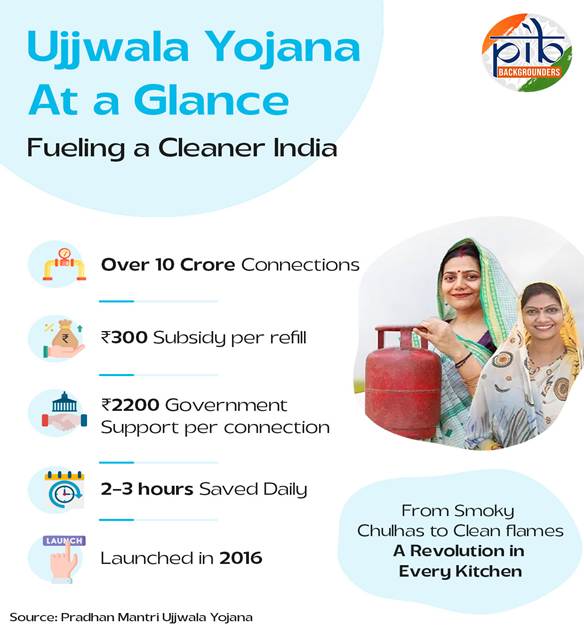
By 2024, Ujjwala 2.0 was furthering the mission of clean cooking fuel access in rural India, reaching deeper into communities already touched by the scheme’s earlier success. In many villages, clean blue flames had replaced smoky fires, and kitchens felt lighter and fresher. Community gatherings like LPG Panchayats became platforms where women shared tips on safe usage, like checking hoses, storing cylinders properly. Also, they exchanged personal stories of easier cooking, fewer respiratory issues, and more time for family or work. They even discovered helpful features of the scheme, such as the ability to change gas agencies through the online portal that added to their confidence and sense of agency. Like millions of households across the country, these communities embraced a quieter, cleaner rhythm: fewer coughs, more smiles.
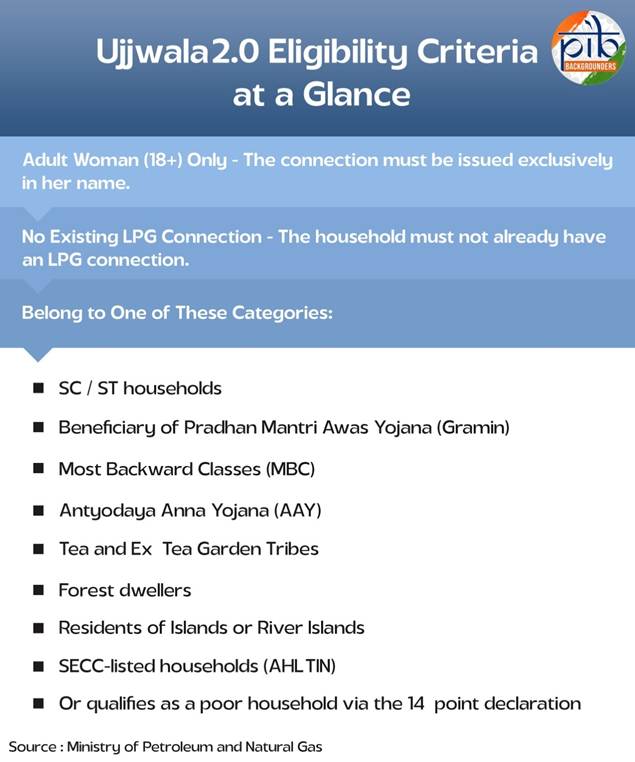
The scheme’s impact shines through stories celebrated at the highest levels. In February 2018, the Rashtrapati Bhavan in New Delhi hosted an event to honor PMUY’s success, where women beneficiaries shared how clean fuel transformed their lives. They spoke of time saved from gathering wood, now spent with children or earning income, and kitchens free of choking smoke. These stories reflect the scheme’s promise of dignity and health. On December 30, 2023, Prime Minister Narendra Modi visited Meera Manjhi’s home in Ayodhya, the 10-croreth PMUY beneficiary.
Fuels of the Past: A Time Before Ujjwala
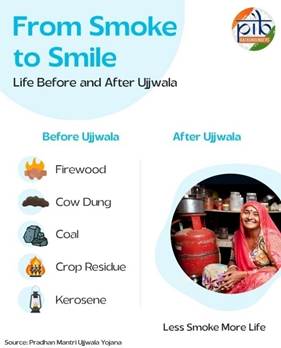
Before PMUY lit up India’s kitchens, rural women relied on traditional fuels that filled homes with smoke and burdened their days with toil. Firewood, coal, and cow-dung cakes were the heart of village cooking, gathered from forests or fields, their heavy smoke clouding lungs and dimming dreams. These fuels, though abundant, demanded hours of labor and left families in hazy, unhealthy homes. PMUY changed this story, replacing smoky flames with clean LPG, freeing women to cook with ease and live with pride.
The table below lists the primary fuels used across India before PMUY’s launch in 2016, highlighting the old ways that Ujjwala transformed.
|
Fuel Type
|
Details
|
|
Firewood
|
Widely used in rural households, collected from forests or local areas, producing thick smoke that impacted health and required hours of gathering.
|
|
Cow-Dung Cakes
|
Common in villages, made from dried dung, burned slowly, releasing heavy smoke that affected family health.
|
|
Coal
|
Used in some rural and semi-urban areas, often for cooking, emitting dense smoke that contributed to indoor air pollution.
|
|
Crop Residue
|
Agricultural waste like straw or husks burned in rural kitchens, adding to smoke and requiring constant collection.
|
|
Kerosene
|
Used in limited households, often mixed with other fuels, producing fumes that posed health risks.
|
Lighting Lives Across States: Ujjwala's Reach
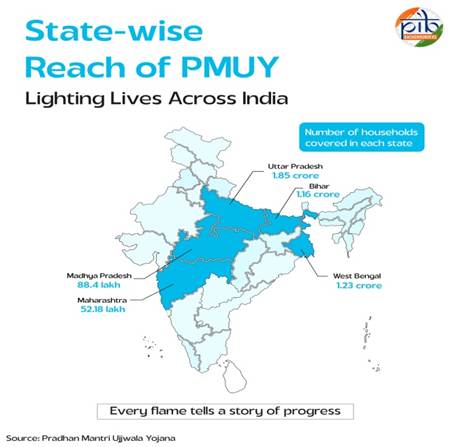
PMUY has kindled hope in every corner of India. States with significant rural populations and poverty indicators have seen greater adoption of the scheme, improving access to cleaner cooking solutions for women.
The table below highlights the states with the highest number of PMUY scheme holders as of December 2024, based on trends in active domestic LPG customers, showcasing the scheme’s widespread embrace.
|
State
|
Number of Scheme Holders
|
|
Uttar Pradesh
|
Over 1.85 crore households, leading due to its large rural population and high LPG adoption.
|
|
Bihar
|
Around 1.16 crore households, driven by widespread rural uptake of clean cooking fuel.
|
|
West Bengal
|
Approximately 1.23 crore households, with strong outreach to underserved communities.
|
|
Madhya Pradesh
|
About 88.4 lakh households, empowering women in tribal and rural regions.
|
|
Maharashtra
|
Nearly 52.18 lakh households have gained access to clean cooking fuel through the scheme.
|
This widespread adoption reflects PMUY’s mission to light up every rural kitchen, with states like Uttar Pradesh and Bihar leading the way in empowering women with clean fuel.
Empowering Women: The Heart of Ujjwala
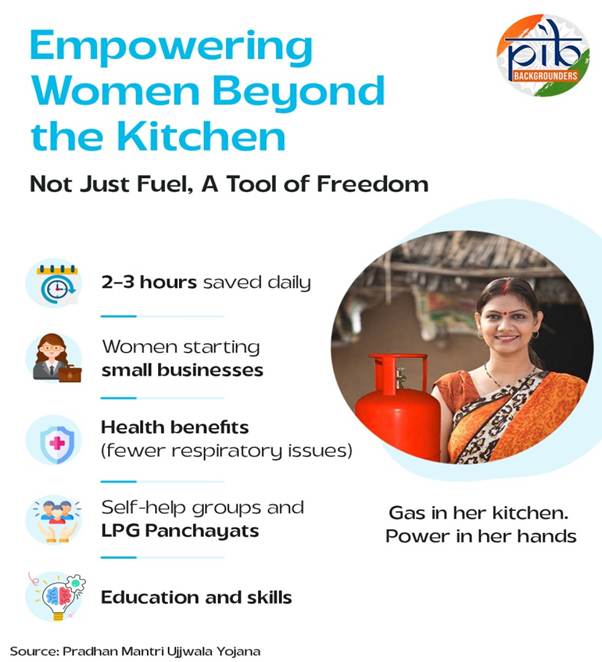
PMUY does more than light stoves, it ignites dreams. By freeing women from the hardship of gathering fuel, it opens doors to education, entrepreneurship, and family time. Women now join self-help groups, start small businesses, or teach their children, their lives enriched by the hours saved and the health gained.
Targets Achieved Ahead of Time
The Pradhan Mantri Ujjwala Yojana not only met but exceeded its key milestones, well ahead of schedule-a testament to its rapid scale, effective execution, and transformational impact.
|
Indicator
|
Achievement
|
|
Initial Target
|
8 crore connections achieved by September 2019
|
|
Ujjwala 2.0
|
Additional 1 crore connections achieved by January 2022; expanded to 1.60 crore by December 2022
|
|
Expanded Reach of Ujjwala 2.0
|
75 lakh more connections approved and achieved by July 2024 under FY 2023–24 to 2025–26 phase
|
|
Total Active Connections
|
10.33 crore PMUY connections active as of 1 July 2025
|
|
Total LPG Refills Delivered
|
234.02 crore 14.2 kg LPG refills (including installation refill) delivered up to February 2025
|
|
Daily Delivery Rate (2024)
|
Approximately 12.6 lakh LPG refills/day delivered during FY 2024–25 (till February 2025)
|
|
Per Capita Consumption Growth
|
Increased from 3.01 cylinders (FY 2019–20) to 3.95 (FY 2023–24), and 4.43 cylinders (FY 2024–25, as of 1 Mar 2025)
|
These achievements tell a story of a changed India. Continuing the transformational journey of PM Ujjwala Yojana, the government has further approved the targeted subsidy of Rs.300 per 14.2 kg cylinder for up to 9 refills per year (and proportionately pro-rated for 5 kg cylinder) to the beneficiaries during FY 2025-26 at an expenditure of Rs 12,000 crore.
SDGs in Action: The Ujjwala Impact
The Sustainable Development Goals are the world’s shared promise—to end poverty, care for the planet, and pillar of this mission, bringing clean cooking fuel to millions and lighting up lives where it matters most help every person live with dignity by 2030. In India, the Pradhan Mantri Ujjwala Yojana stands as a strong.
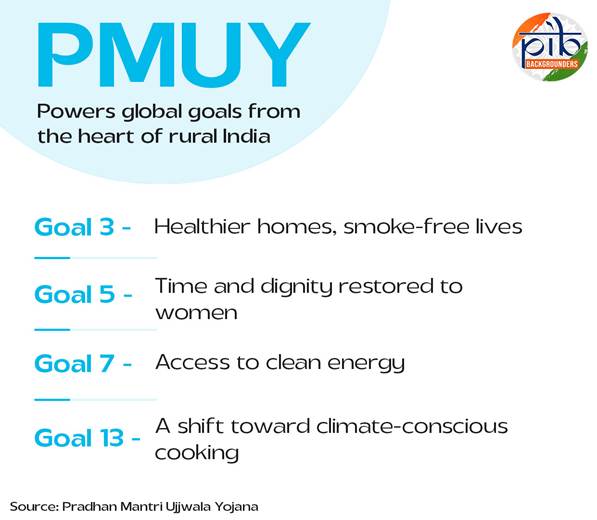
Conclusion: A Flame of Hope for Tomorrow
The Pradhan Mantri Ujjwala Yojana is more than a scheme. It is a revolution of hope, kindling flames that warm hearts and brighten futures. Each gas cylinder, backed by generous subsidies, is a spark of dignity, freeing women from smoky kitchens and lighting the way to healthier lives, empowered dreams, and thriving communities. From Uttar Pradesh to Maharashtra, millions of women now cook with pride, their children breathing freely, their homes filled with laughter.
Cameliya’s Kitchen
In South 24 Parganas, West Bengal, Cameliya Naskar lived with a quiet enemy—smoke. It curled through her kitchen, filled her children's lungs, and settled into every corner of her home. Her days were a blur of coughing, cleaning, and cooking through the haze.
But now, the air is different.
Her stove runs on LPG, and her kitchen no longer chokes her dreams. The walls are still the same, but the mood is new. Warm meals simmer on the stove while her children study beside her. Her home, once filled with soot, is now filled with the smell of food, the sound of learning, and the lightness of hope.
|
Prime Minister Narendra Modi captured this spirit in 2019: “Ujjwala Yojana has put great emphasis on the resolve of ensuring health, convenience and empowerment of sisters.”
That’s the essence of Ujjwala, a flame that lights both the kitchen and the spirit, carrying hope to every corner of India. PMUY stands as a beacon of India’s progress, where clean, accessible fuel fuels not just stoves but aspirations, weaving a tapestry of equality, health, and opportunity. As these flames flicker in every corner of the nation, they carry a promise: a brighter, stronger India, where every woman’s light shines bold and free.
References:
- Ministry of Petroleum and Natural Gas
https://pmuy.gov.in/about.html
https://pmuy.gov.in/about.html
https://pmuy.gov.in/faq.html
https://cag.gov.in/uploads/download_audit_report/2019/Report_No_14_of_2019_Performance_Audit_of_Pradhan_Mantri_Ujjwala_Yojana_Ministry_of_Petroleum_and_Natural_Gas_0.pdf
https://www.niti.gov.in/sites/default/files/2024-01/MPI-22_NITI-Aayog20254.pdf
https://www.niti.gov.in/sites/default/files/2023-08/India-National-Multidimentional-Poverty-Index-2023.pdf
https://x.com/PMOIndia/status/1000951055260106752
https://www.pib.gov.in/PressReleasePage.aspx?PRID=1876494https://www.pib.gov.in/PressReleseDetailm.aspx?PRID=2082313https://www.pib.gov.in/PressReleasePage.aspx?PRID=1940125
https://www.pib.gov.in/PressNoteDetails.aspx?ModuleId=3&NoteId=151863
https://www.pib.gov.in/PressReleseDetail.aspx?PRID=1800599https://www.pib.gov.in/PressReleasePage.aspx?PRID=2130798
https://www.pib.gov.in/PressReleasePage.aspx?PRID=2149224
https://www.pib.gov.in/PressNoteDetails.aspx?NoteId=154355
https://www.pib.gov.in/PressReleasePage.aspx?PRID=2035039
https://www.pib.gov.in/PressReleasePage.aspx?PRID=1541545
https://static.pib.gov.in/WriteReadData/specificdocs/documents/2023/may/doc202351192201.pdf
https://static.pib.gov.in/WriteReadData/specificdocs/documents/2024/mar/doc2024315325001.pdf
https://www.pib.gov.in/PressReleasePage.aspx?PRID=2149224
https://www.pib.gov.in/PressReleaseIframePage.aspx?PRID=1957091
https://www.pib.gov.in/PressNoteDetails.aspx?NoteId=154355
https://www.pib.gov.in/PressReleaseIframePage.aspx?PRID=1991792
https://www.pib.gov.in/PressReleasePage.aspx?PRID=1743813
https://sansad.in/getFile/loksabhaquestions/annex/184/AS59_J9qBOS.pdf?source=pqals
https://static.pib.gov.in/WriteReadData/specificdocs/documents/2023/may/doc202351192201.pdf
https://sansad.in/getFile/annex/267/AU2677_nVI8vB.pdf?source=pqars
https://www.youtube.com/watch?v=Fr5SuKDvpZg&t=381s
Click here to see PDF
SK/M
(Backgrounder ID: 154997)
Visitor Counter : 7